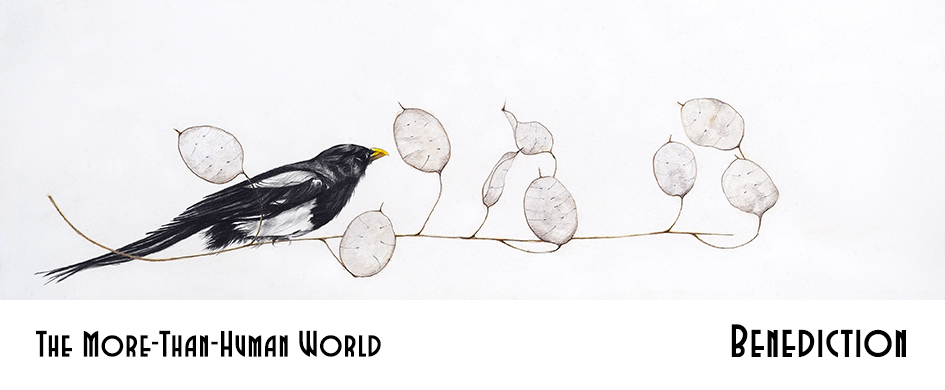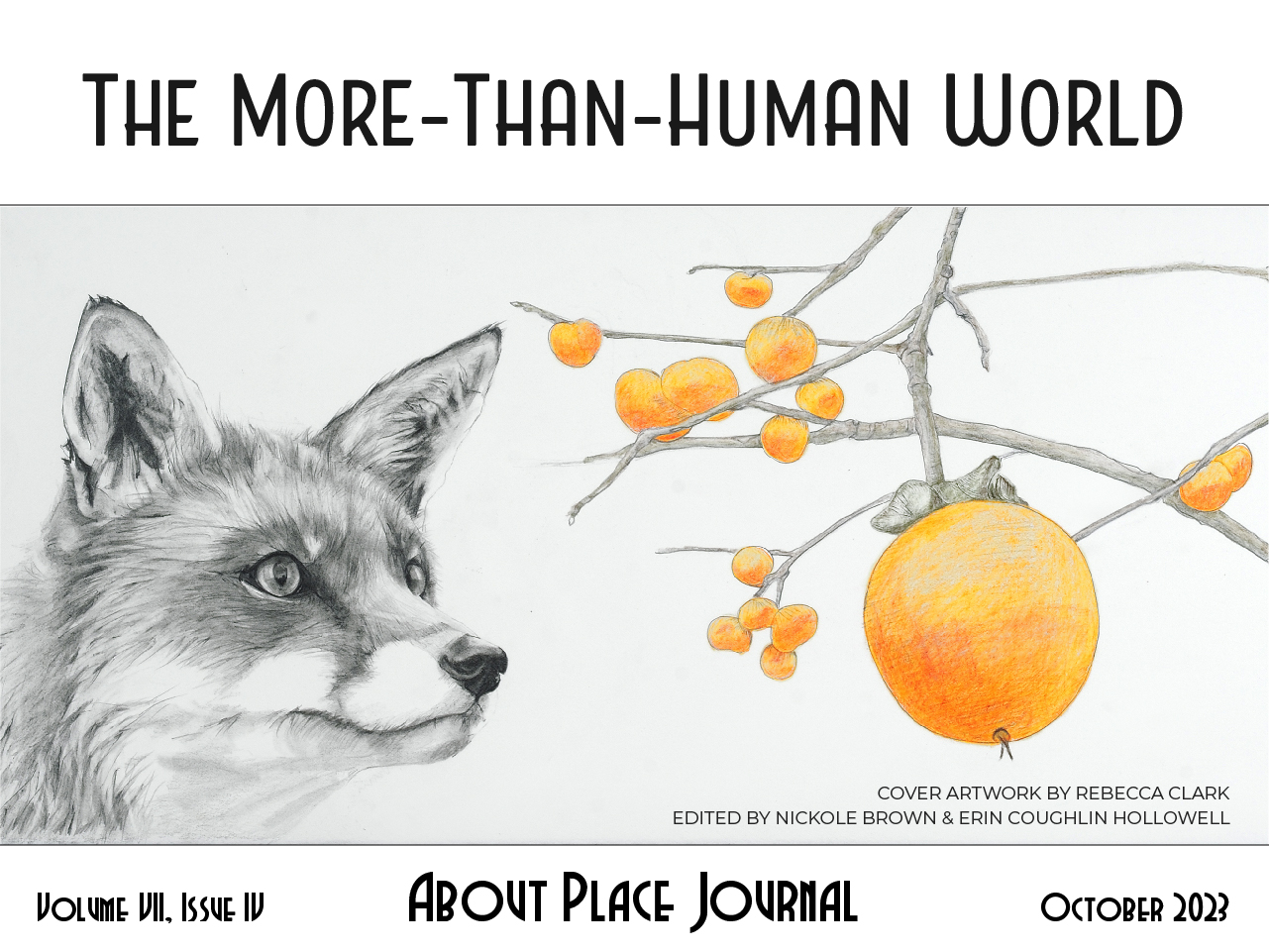A fig is not a fruit. A fig is a flower head encased in a fleshy, exoskeletal stem that botanists call a syconium. A fig is an internal meadow.
A fig tree probably doesn’t care whether we call its produce a fruit or an inflorescence, but it’s a relevant distinction. Because a fig is a set of flowers, it needs to be pollinated in order to create seeds, and because it is encased, it needs a highly specialized pollinator to climb through a small opening in the ostiole. Enter (heh) the fig wasp.
An adult wasp wriggles inside the fig, losing her wings in the process, and deposits her eggs (and the pollen she carries from the fig where she was born) inside. Flowers become seeds, and the fig digests the body of the fallen queen, turning her to nutrients. The eggs hatch, the new wasps mate and collect pollen, and the females escape to continue the cycle in other figs.
A fig is a crossroads, a locus where uncountable elements transform each other. Starlight, rainwater, waspwing, soil, smog, machete, wind, fox dung, bat dung, quail dung… you see where this is going.
A fig is wasp cradle and wasp grave, a tree is an orgy in a cemetery, and each lime green or dark purple globe contains enough seeds to ravage and ravish a countryside.
:::
Henry David Thoreau famously wrote, “I have great faith in a seed… Convince me that you have a seed there, and I am prepared to expect wonders.” Less well known is the fact that he painstakingly tracked the dispersion of seeds by animal and wind and river and snowmelt. He recorded the succession of generations of trees in local forests and farms. He trudged, surveyed, dug, collected, measured, and climbed in pursuit of perspective on the ways of the plants.
In the mid-nineteenth century, a large swath of the American population believed that trees spontaneously generate or are created by divine intervention. When a lumber farmer cuts down a pine lot and later finds an oak grove there, it must be that God’s hand introduced the new species, the thinking went. So Thoreau the Transcendentalist spent seasons observing wood lots and closely analyzing dozens of kinds of seeds, their unique properties, and the ways they get themselves transported, all in order to convince his neighbors that trees always grow from seed and never spring up spontaneously. Far from explaining away the transcendent nature of the process, Thoreau called his seed conclusion an “equally mysterious origin” of plant life.
The lesson? Sometimes mysticism needs to get its hands dirty.
:::
One of my favorite pastimes is “stealing” seeds. Of the nasturtium vining under the wooden fence of the ranch house with immaculate landscaping. Of the poppies in the community garden. Of the milk thistle – for medicine – along the periphery of a privately-owned orchard. I say “of” and not “from,” for the plants do not seem to assert a claim of ownership over the seeds they produce – it’s just humans who do that – and not even humans, usually, but businesses and corporations and trusts.
Nasturtium seeds, by the way, are pleasantly reminiscent of dried peas, but colored and grooved more like peanut shells. The seedpod of the California poppy looks like a slim, curved, green bean, and when it’s ready for harvest, it’ll often split open at the lightest pressure of your fingers and scatter its tiny seeds as if they’re spring-loaded. The milk thistle seed (like other thistles) is attached to a tuft of white down, evolved to carry it on the wind, and the seed itself is said to be good medicine for the liver and an emergency antidote to Amanita mushroom poisoning.
It’s an animal pleasure, the satisfaction of collecting tiny treasures. We’re coevolved with the seed-bearing plants. That feeling of wonder when holding a handful of seeds and imagining what they might become? That’s part of how evolutionary biology feels in the first-person.
:::
Why do plants make seeds? It’s a ridiculous question, I know, as the answer is both seemingly obvious and ultimately unknowable. But I believe it’s a question worth sitting with.
A version of the obvious answer is “to replicate their DNA.” The answer to the next “why?” might be something like, “because their DNA tells them to.” Maybe so. Still, I find this answer less than compelling. You might say the same thing about the reproduction of humans, for example, or chimpanzees, or chickens, but if you’ve ever spent time observing any of them, you know that “instinct” fails to capture the complexities, idiosyncrasies, and lived meaning of kinship. Perhaps you’ve tried to steal eggs from a brooding hen (here, I do say “from”) and looked into her fierce eyes. There’s an intensity, an animacy, a locus of experience that goes beyond the unthinking-ness we sometimes mean when we say “instinct.” Even if all of it is reducible to DNA, it goes beyond DNA.
:::
There’s a certain kind of rhythm in the perennial plant’s life, a year-long slow dance leading up to seeding. The phases the plant shifts through in the process. Seasons in the body. Humans use metaphors like path, progress, and direction to talk about the meaning we make of our lives, because movement is one of our lifeways. We are always walking or wheeling. We are nomads even when we make home and return to it. The plant’s got rhythm, phase, season, instead.
The process of seed-making might lead to the plant creating more of its kind, but it also leads to feeding local fauna (through pollen and fruit, as well as seed) and creating all kinds of micro-interactions with its community. Communion! Breaking bread together, the body as food, all that.
Reproduction, which we sometimes interpret as the most fundamental aspect of plant biology, the primary purpose of a plant’s life, turns out to be mostly non-reproductive. Most seeds never become plants. They are eaten, drowned, baked, molded, lost, forgotten. In a human-centric (or, really, capital-centric) perspective, we might call this wasteful.
Maybe, instead, it’s part of the point.
:::
In his studies of plant distribution, Thoreau often reflects on the astronomical scale of seed production. Considering the fact that only “one in a million” willow seeds will become a tree, he asserts that this is good, “for if every white-willow seed were to become a tree like this, in a few years the entire mass of the planet would be converted into willow woods.” So too the thistle; he calculates that the fifth generation of one individual thistle would produce nearly eight trillion seeds: “a progeny […] more than sufficient to stock not only the surface of the whole earth, but of all the planets in the solar system, so that no other vegetable could possibly grow.” I have not checked his math, but I’m willing to accept it provisionally.
In Thoreau’s telling, vegetal reproduction would be swiftly apocalyptic if it weren’t “wasteful.” By giving so much of itself away, losing its seeds to the uses and non-uses different environments might put them to, the plant preserves its world.
:::
A friend of mine, a software engineer who’s always tinkering with machines and codes – who has, in fact, been obsessed with computers since before I was alive – has recently taken to gardening. It’s a marvel to watch an engineering mind tackle the problems of horticulture: daikon radish to loosen up the soil, experiments in hydroponics, and so forth.
Walking me through his garden, this Platonic ideal of a gadget guy turned to me and said, “Screw the 3-D printer.” He held up a seed between thumb and forefinger – maybe a bean, or a nasturtium seed, I’m not sure – and continued, “Now this is powerful programming.”
:::
A plant devotes massive amounts of its time, energy, life force, and ingenuity into creating seeds – possibilities, aspects, offshoots – and then gives them away, surrendering any notion of control or guidance.
I don’t think human/mammal reproduction is a good analogy for this. We might sometimes call human sperm seed – and indeed, humans chose to name the seed-bearing plants spermatophytes – but this is biologically inaccurate. A seed is an embryo. A plant produces so many more embryos than mammals do, and then throws them to the wind (or the birds, or the rodents, or the creek). One study says winter wheat has an average of 22 seeds per head and 5 heads per plant, for an average of 110 seeds (embryos). A white oak has been known to produce 23,000 acorns (embryos) in a single year.
If I had been absentmindedly working towards an ars poetica, a suggestion that writing or art-making is a better analogy here than mammal reproduction, the sheer calculative logics would make it difficult. Even Tolstoy’s got nothing on a white oak.
:::
As part of his “great faith in a seed” passage, Thoreau also wrote: “I shall even believe that the millennium is at hand, and that the reign of justice is about to commence, when the Patent Office, or Government, begins to distribute, and the people to plant, the seeds of these things.”
At first blush, Thoreau is speaking metaphorically, here. If one of the purposes of developing an anti-anthropocentric, or non-human-centered, perspective is to consider the livelihoods of the plants as just as important – or more important – than our own, it might seem disappointing to return to the world of patent offices.
But I’d like to believe that there is much middle-ground between the anthropocentric view of plants as metaphors or resources, and a hypothetical vegeto-centric view of plants as nothing more than themselves. Indeed, they are already entangled with other lives and elements as they are in themselves. Remember the fig?
So, plants as teachers and guides. Plants as friends and neighbors. Fellow citizens? Beings with something to offer to discourses of ethics and justice?
Create more than you need. Give it all away. Nothing is wasted.


